WASHINGTON, DC
JANUARY 29, 2015
STRANGER: Gary Krist
LOCATION: Acadiana, 901 New York Avenue NW, Washington, DC
THEME: Dinner to discuss the battle for modern New Orleans
Empires can span continents — or just a few city blocks.
In the early part of the 20th century, New Orleans experimented with what author Gary Krist calls an “empire of sin,” a city zone known as Storyville where prostitution, then-scandalous jazz music, drunkenness and debauchery of all kinds were tolerated — even encouraged.
But empires rise and fall, and evangelicals and moralizing reformers pushed back on the freewheeling district. Rising crime rates due to the arrival of the Italian mafia made the sinful district more dangerous, and eventually the teetotalers and other crusaders won the day.
It’s a fascinating story that Gary, who lives in Bethesda, Maryland, pieced together after more than a dozen research trips down to the Big Easy. His non-fiction book, Empire of Sin: A Story of Sex, Jazz, Murder, and the Battle for Modern New Orleans, describes the ascent and decline of Storyville through a host of narrators ranging from jazz musicians to reformers. But the primary character is Tom Anderson, a saloon owner, politician and unofficial “mayor” of the district where vice was king from the early 1900s to 1920.
I’m in love with present-day New Orleans for everything it offers from great food and outstanding music to strong drinks and a culture that embraces the good times. But Gary’s book was a page-turning window into an earlier Crescent City that I knew very little about.

Eager to learn more about how he got interested in turn-of-the-century New Orleans, I invited Gary to a dinner interview and we settled on Washington’s Acadiana restaurant. The venue, which he suggested, was highly appropriate as it’s got a menu packed with dishes you might find down South, ranging from turtle soup to crawfish, and a cocktail list one could find on Bourbon Street.
We started our meal with two fine drinks: a sazerac for me (the signature cocktail of New Orleans, muddling together rye, herbsaint and bitters) and a doubloon for Gary (Maker’s Mark, St. Germain, simple syrup and house-made bitters).
While we sipped on the strong libations, Gary — a New York Times-bestselling writer — explained that he’s developed a love of urban history with Empire of Sin and his predecessor book, City of Scoundrels, which chronicled 12 tumultuous days in Chicago in 1919 when race riots, a transit strike, a murder and more helped shape the city’s transition to a modern city.
Gary jokes in Empire of Sin‘s acknowledgments that his family accuses him of writing books about cities he’d like to visit, and he admitted to me that there’s a lot of truth in that. After he’d chosen his preferred location, it was time to craft a coherent narrative about the city.
To start, “I do an awful lot of reading,” he said. On his 13 research trips to New Orleans he would also try to befriend academics, librarians and archivists to guide him to the most appropriate material. “I immerse myself as best I can, but it takes years to do.”
Empire of Sin took three-and-a-half years of digging into the city’s past. “There’s a certain amount of academic rigor involved” in writing a historical book, he said, noting that his tale includes more than 50 pages of citations and notes at the end. But he enjoys it. “There are some days when all I do is read, which is one reason I love my job. I feel like I’m being paid to be a graduate student.”
He smiled and took a sip of his cocktail, while our waiter approached and set down two biscuits, served with a side of Creole cream cheese and jalapeno jam.
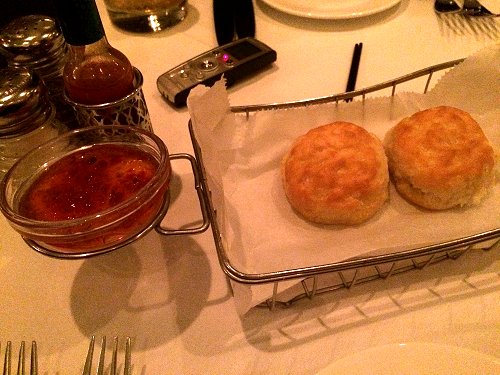
The biscuits made for a great snack ahead of our three-course meal, and while we ate them I asked Gary more about his research for the book.
All of the central characters in the Storyville saga have long since passed away, so Gary had no opportunity to interview front-row witnesses to history. Instead, he relies on court transcripts, microfilms, newspapers and the occasional unpublished memoir or autobiography. Talking to historians helps him to get guidance on where to focus his extensive research.
“One of the great discoveries when you write about history is that the historical record is full of noise. What is chosen as signal in that noise depends in a large part on the historian,” Gary said. When he gives talks on writing, he often tells the example of how the Titanic disaster has become a story of hubris: the unsinkable ship that sank to the bottom of the Atlantic Ocean. “But is that really the story about the Titanic? Or did some early historian see some obscure marketing document that the Red Star Line put out calling Titanic unsinkable? Perhaps they didn’t really emphasize that, but the first historian saw it and thought it made a great story,” he said.
After compiling a wealth of research, Gary has to decide what balance to give it, explaining it all in the notes section. “Often it’s a reasonableness standard: This person has a really vested interest in lying and this person does not, so I will give more credence to the second person,” he said.
The only way to avoid getting spun on decades-old stories is for researchers to go into the archive materials, Gary explained. “You see whether something has been exaggerated to the detriment of something else. Any narrative is a selection, and any selection is subjective. So it is a question: What is history? It really is a perspective on this chaos.”
Gary’s perspective in Empire of Sin focuses heavily on the creation of Storyville and the desire by the city’s officials to keep some kind of control over prostitution by confining it to that particular district. There was also a separate “black Storyville,” showing that despite the laizzez faire attitude to sin, New Orleans had racial problems just like the rest of America — although Gary notes often in the book that race relations were, if not ideal, at least more fluid in Storyville. Many white customers would pay for octoroon or black prostitutes, and loved black jazz (or “jass”) music.
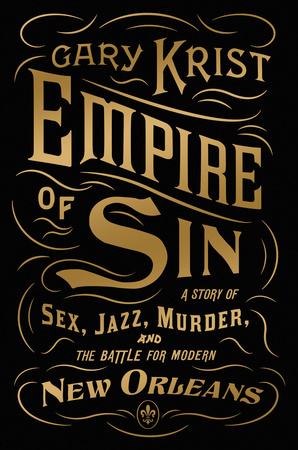
Tom Anderson was a savvy businessman who saw the potential of Storyville, and his saloon acts almost as a city hall for the area throughout the book. It’s where he held court, and it’s where in later years undercover regulators would attempt sting operations for the increasing restrictions that reformers pressured the city into adopting, such as limits on when alcohol could be served.
Anderson, along with district madam Josie Arlington, who ran a major city brothel, serve as a pair of charismatic characters that it’s difficult not to like to some extent. Though they’re dealing in sin, they both come across as charming personalities and not as brutal, self-serving criminals.
Their primary opponents were the reformers, such as moral crusader Jean Gordon, strongly opposed to any implicit legalization of prostitution, drink, or other sins. But those people had flaws too, which Gary points out in the book — including Gordon’s ghastly support of eugenics.
I wondered how Gary sifted through the noise of history when he’s got such vivid competing characters to deal with. He said, “I try to be fair to everybody, but I do have a perspective.”
Some reviewers of Empire of Sin have noted that the author appears to side more with the Storyville residents than the moralizing reformers, and he concedes the point to some extent. “How can you not take a position against eugenics? It wasn’t intentional, but it was just what I found: Those progressives, or reformers, have some real blind spots, particularly on the race issue.”
Anderson and the others have blind spots too. Crime was a problem in the Storyville district that only got worse as the Italian mafia grew in strength. Shootouts were common, including a vivid scene Gary describes where so many bullets were flying even the newspaper accounts of the time were confused about who shot whom.
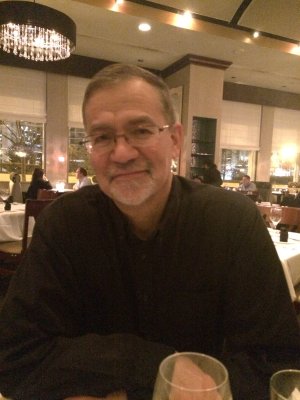
At its heart, the district was dealing in what people might see as harmful behaviors, like selling sex for money. “Everybody knows that killing somebody else is bad. Even the guys who were doing the killing knew it,” Gary says of the sin merchants in Storyville.
But then he shifts his focus to the reformers aiming to shut down the district, saying, “What is more insidious is people that clothed themselves in sanctimony and claimed they were doing God’s work, and meanwhile are taking girls to be de-sexed because they looked like they might have a future in prostitution or alcoholism. Naturally I’m going to be harder on those people.”
Yet he recognizes the numerous negative aspects of the sin empire, and the book is extremely careful to walk an independent line that offers up a narrative without firmly taking sides. “There’s a tendency to see Storyville as colorful and harmless. But it wasn’t harmless. I made sure to include a paragraph in the book saying that there was a fundamental degradation for both customer and provider in this exchange of sex for money. I don’t want to romanticize anything,” he said.
Still, for many women of minimal means, prostitution gave them a career that allowed them to empower themselves. They were making good money and didn’t necessarily agree with the likes of Prohibition activist Carrie Nation, who argued that the women were destined for hell. “I don’t want to underplay the degradation and pain of this way of life, but I don’t want to say they were all poor helpless victims. These were assertive independent women who made a choice,” Gary said.
Josie Arlington provides one of the story’s most vivid examples. Starting by selling apples on the streets of New Orleans, she founded a lavish house of sin that would ultimately pull in thousands of dollars. That money funded a mansion far away from Storyville where Josie could live out her dream life of being a high-class society woman.
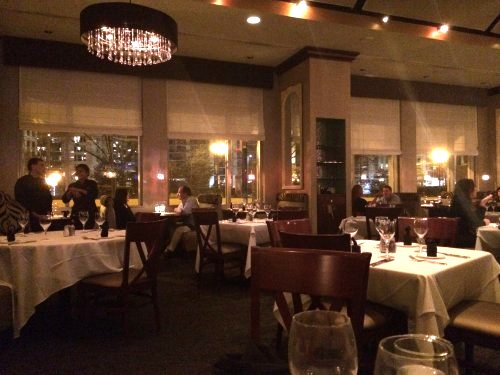
Still, the high times of Storyville came to an end in 1920 thanks to a combination of factors, including World War I, the nation’s brief dalliance with Prohibition, the increasing clout of the reformers, and political winds of change. Even the story’s leading man, Tom Anderson, finds himself embroiled in a court battle over his estate, ending the book a seemingly broken man.
Although none of the characters from Empire of Sin are around to tell their sides of the story, Gary did manage to locate Anderson’s great grandson — although he said the meeting wasn’t hugely productive from a research point of view. “It was a lot of fun, we got a little tipsy, and we had a wonderful time. But unfortunately he had very little information to offer. I kept hoping he’d invite me to see an attic full of a box of materials – and that’s happened before,” said Gary.
“Serendipity plays so much of a role in what I do. So many of the best things have happened by accident, through somebody I was introduced to,” he added.
During his research for Empire of Sin, one such serendipitous encounter happened in his quest to find the transcript of the court battle over Tom Anderson’s estate. The parish clerk didn’t have it. The county clerk didn’t have. The state clerk couldn’t find it. But then one of Gary’s contacts connected him with the deputy clerk of the Louisiana Supreme Court — and he had it. The discovery helps add extensive color to the trial, down to the times when Anderson muttered under his breath.
“Accidents happen all the time and I rely on them,” said Gary.
His research trips helped him make new friends, including Alecia Long, a history professor at Louisiana State University. She’d written a scholarly book, The Great Southern Babylon: Sex, Race and Responsibility In New Orleans, 1865-1920. Gary thought she’d be a good resource, albeit a potentially intimidating academic. “It turns out she’s the most approachable, wonderful person and we became friends. And that was another very boozy evening — one tends to have that in New Orleans,” he said with a laugh.
By now we’d moved on to splitting a bottle of wine, destined to follow the same pattern at Acadiana. That’s why I was glad the starter arrived to help me soak up some of the alcohol.

Gary opted for the turtle soup, a popular dish down in New Orleans at such establishment restaurants as Arnaud’s and Commander’s Palace. He had praise for the dish.
Thankfully he also had room to help me out with my order of charbroiled oysters.
My one tryout with raw oysters in New Orleans last year turned my stomach, but I figured that Acadiana’s version — cooked, swimming in garlic butter and parmesan romano cheese — might sit better with me. I was right. These were delicious, and the hefty chunk of french bread that came with the dish was a brilliant idea, as I could use it to soak up every oily drop from the shells.
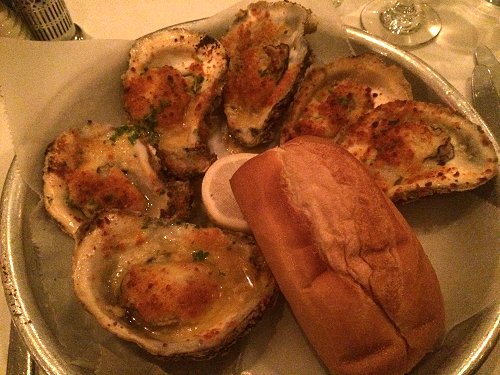
While we both worked on the oysters, we exchanged stories about our favorite restaurants in the Crescent City, as well as the various experiences we’ve had down there.
Gary said that he was initially concerned that people in New Orleans might see him as something of a carpetbagger, coming to their city to write about its history. But he said the reviews written by people who have lived there — including from the New York Times and Washington Post — have been positive. “They basically said I got it right, so I feel vindicated,” Gary said.
Nowadays New Orleans has a reputation as a party city, one that draws in tourists expecting to see revelry on Bourbon Street, jazz music echoing around the French Quarter and an attitude of “let the good times roll.” It’s a somewhat fair description, though the city has a lot more to offer culturally. And it’s come a long way from the days of the empire of sin.
Could the legalized district have worked? Gary sat back and thought. Then he said that one of his surprises with the book was learning that the district started as a reform initiative, a way to try and isolate and neutralize problems of sin by confining them to one area.
“Then it got out of hand. I do think that there’s very little point in trying to stop something that is not going to be stopped. You can either work with human nature or against it, and if you’re going to work against it you will lose. The problem in Storyville is that organized crime moved in. I think if it had been more tightly regulated it could have worked.”
But the reformers won the day, and now Storyville is just another neighborhood of New Orleans, Tom Anderson’s saloon and Josie Arlington’s brothel long since gone.
Empire of Sin is Gary’s eighth book, and his third historical story following City of Scoundrels and its predecessor The White Cascade, about a 1910 avalanche in Washington state.
He hasn’t been a writer his whole life. Born in Jersey City, New Jersey, he went to Princeton University — where he met his future wife — and then from 1979 to 1980 studied literature at Germany’s Universitaet Konstanz on a Fulbright Scholarship, then lived in New York.

“When I came back after the Fulbright, I wanted to get a job in publishing, but I couldn’t type 50 words per minute, so nobody would look at me,” Gary said. So eventually he took a job with Kaplan editing academic materials, despite his general reluctance to enter that field. To his surprise, he found many of his colleagues were budding actors, painters, writers and other creative types. “It was a great place for an artist to be working in New York,” he said.
After about two years with Kaplan, Gary wanted to act on his desire of being a writer and reduced his workload to a half week, a schedule he kept up until 1995, when he became a full-time writer.
He wrote two collections of short stories which he said “did not sell, but got nice reviews so I had some credibility as a writer.” After that, he wrote two literary thrillers, before working on a labor of love novel that jumped in time between 17th century London and 1990s New York. Gary said it got mixed reviews and sold “miserably,” but that he greatly enjoyed some research trips that he took to London when he was planning the novel.
One day, his agent suggested that if Gary enjoyed doing research, he might want to try his hand at writing historical non-fiction, which could bring in more money. He agreed, and The White Cascade was the result. “I loved the experience, and haven’t looked back since.”
It was a change in his wife’s job that brought the Krists to Maryland. “It was a great place to raise a kid,” Gary said. “And there’s a very supportive community of writers here. Everybody is pushing each other’s books,” he said. And working from his home in Bethesda means he gets to enjoy the necessary solitude to compose his books — all written long-hand, then typed up.
“I think I have a distinctive style, I write really long sentences but I think they are tightly constructed in terms of logic so that people don’t get lost in them,” he explained.
We were about to get lost in our main courses, seafood for Gary and meat for me.
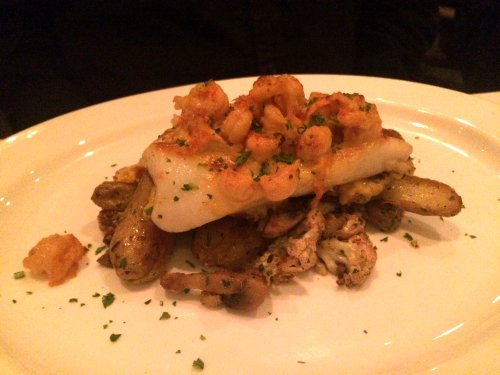
Gary’s dish was the flounder crawfish glasage, served with fingerling potatoes, cauliflower and roasted mushrooms. It looked outstanding, and he had compliments for it.
I’d gone for the grillades and grits, finally ending a years-long quest to have that dish. I’d first seen it when former interviewee Anne Rolfes enjoyed it at the restaurant Luke in New Orleans’ Business District. I’ve been jealous of her choice ever since, but never experienced it.

So when I saw it on offer at Acadiana I had to have it. Sautéed veal medallions were served with jalapeño cheese grits and a wild mushroom pan gravy. Amazing. Well worth the years-long wait, this was a hearty, rib-sticking dish perfect for the cold weather.
While we ate, Gary offered a few details on his next book.
He has a rough plan to write about Los Angeles in the early 1900s, particularly the silent movie era. Again, he chose a place he’d like to visit but that also meets the threshold of having an interesting history. As a fan of urban history, he said he loves discovering new places. “I think if I weren’t a writer, I would be a travel agent. I love planning travel. If I’m not planning a trip, I’m not happy.”
Right now he’s collecting his notes and doing research ahead of writing a book proposal for the Los Angeles project, a vital step to get his publisher on board. Ongoing research — reading biographies of early movie directors, making early trips to the city — helps Gary to identify the narrative, which in turn will result in the proposal that will likely run anywhere from 50 to 150 pages. “You really have to know what you’re doing by the time you do the book proposal,” Gary said. “I used to think I could say, ‘You know I’m a good writer, and this city is interesting, so give me a check.’ But no. I adore my editor and publicist, but they want to see what the book is.”
He’s already made a good connection with former Los Angeles Times reporter Lynell George, who reviewed Empire of Sin for the Chicago Tribune. “It was the kind of review every writer dreams of, there was something positive in every sentence. I felt like she really engaged with the book,” Gary said. He doesn’t always write to his reviewers, but felt compelled to send Lynell a thank you note. She wrote back, and after talk of Gary’s next project, she offered to help with his research. They met in Los Angeles, and Gary said she’s been a good boost to his efforts.
Given his extensive writing experience, Gary said the editorial process for his books is less of a line-by-line copy-edit and more a letter he receives back from his editor, which provides input on “meta things,” such as him placing too much emphasis on one idea in a particular chapter. “Because I’ve been at this for a long time, I give them manuscripts that are really polished,” Gary said.
The editor’s input aims to improve the book, but it’s ultimately Gary’s decision whether to adopt that advice. “I know that we are all on the same team. I know that I have certain academic standards that I insist on keeping, but I’m very aware of the commercial aspects too,” he added.

He paused for a moment as the waiter set down our dessert. “I’m not usually a big dessert guy,” Gary said, watching as we were served three scoops of pistachio, chocolate and bananas foster ice cream, the latter flavored like the flamed bananas, caramel and ice cream dish of New Orleans.
Still, I encouraged Gary to join in the dish, and while we sampled the various flavors — all good — he said the only thing he’s not a fan of with writing is the marketing of his books.
Although he says he has “a lot of wonderful experiences” on books tours and doing radio, television and other promotion, he described himself as generally a private person who likes solitude. “My idea of a wonderful day is a day in which I have nothing planned and can control it entirely,” he said.
“I’ll do the promotions because it’s what one has to do now. But I’m really happiest when it’s over and I’m just working on the new book,” he added with a smile. “I wake up in the morning really eager to get to work, which is a rare thing.”
Gary appears to have been a very good dinner mate indeed and I could almost smell the gravy. I like to take away something of everything that I read and the notion that “history is merely ones perception of chaos” is a great find. It also goes to great links in explaining the Republican party! Just saying….
0v67sf
na3oub